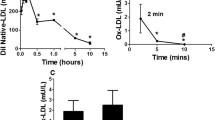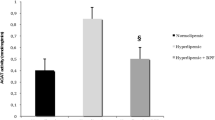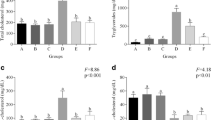Abstract
The purpose of this study was to investigate, for the first time, the effects of Bifenthrin (Bif) chronic exposure on plasmatic and aortic lipid parameters disturbance and their pro-atherogenic possibility in Wistar rats. The ameliorative role of vitamin E (Vit E) and selenium (Se) were also targeted. Thus, rats were treated by gastric gavage with combination of Vit E (100 mg/kg/bw) and Se (0.25 mg/kg/bw) in alone and co-treated groups for 90 days. Apart from control and Vit E-Se groups, all the groups were subjected to Bif (3 mg/kg, via gavage) toxicity. Results showed that Bif increased markedly plasmatic and aortic total cholesterol, LDL-cholesterol, native LDL-apoB-100, and oxidized-LDL, compared to the control. Moreover, Bif treatment significantly increased the plasmatic levels of the pro-inflammatory cytokines TNF-α, IL-2, and IL-6. In addition, the densitometric quantification of protein bands showed that the amount of hepatic native LDL-receptor protein decreased significantly in the intoxicated rats compared to the control group. The expression of arterial LDL receptors (LDLRs) and scavenger receptors (CD36) was amplified owing to Bif toxicity. This harmful effect was confirmed by histological study using Oil-Red-O staining. Owing to their antioxidant capacities, Vit E and Se have maintained all the changes in plasma and aorta lipids and prevented the pro-atherogenic effect observed in Bif-treated animals.







Similar content being viewed by others
References
Abarca-Gomez L, Abdeen ZA, Hamid ZA, Abu-Rmeileh NM, AcostaCazares B, Acuin C (2017) Worldwide trends in body-mass index, underweight, overweight, and obesity from 1975 to 2016: a pooled analysis of 2416 population-based measurement studies in 128$9 million children, adolescents, and adults. Lancet 390(10113):2627–2642
Acker CI, Nogueira CW (2012) Chlorpyrifos acute exposure induces hyperglycemia and hyperlipidemia in rats. Chemosphere 89:602–608
Allagui MS, Hachani R, Saidi S, Feriani A, Murat JC, Kacem K, El Feki A (2015) Pleiotropic roles of melatonin against aluminium-induced toxicity in rats. Gen Physiol Biophys 34:415–424
Beytut E, Yilmazb S, Aksakalc M, Polat S (2018) The possible protective effects of Vit E and Se administration in oxidative stress caused by high doses of glucocorticoid administration in the brain of rats. J Trace Elem Med Biol 45:131–135
Çetin E, Kanbur M, Silici S, Eraslan G (2010) Propetamphos-induced changes in haematological and biochemical parameters of female rats: protective role of propolis. Food Chem Toxicol 48:1806–11810
Chen J, Han JH, Guan WT, Chen F, Wang CX, Zhang YZ, Lv YT, Lin G (2016) Se and Vit E in sow diets: I. Effect on antioxidant status and reproductive performance in multiparous sows. Anim Feed Sci Technol 221:111–123
Chen YL, Xiao CH, Hu ZX, Liu XS, Zhao XJ (2017a) Dynamic lipid profile of hyperlipidemia mice. J Chromatogr B 1055-1056: 165–171
Chen H, Li YJ, Sun YJ, Gong JH, Du K, Zhang YL, Su CF, Han QQ, Zheng XK, Feng WS (2017b) Lignanamides with potent antihyperlipidemic activities from the root bark of Lycium chinense. Fitoterapia 122:119–125
Damalas CA, Koutroubas SD (2016) Farmers’ exposure to pesticides: toxicity types and ways of prevention. Toxics 4(1):1
de Sousa JA, Pereira P, Allgayer MC, Marroni NP, Ferraz ABF, Picada JN (2017) Evaluation of DNA damage in Wistar rat tissues with hyperlipidemia induced by tyloxapol. Exp Mol Pathol 103(1):51–55
Debabrata P, Sivakumar M (2018) Sonochemical degradation of endocrine-disrupting organochlorine pesticide Dicofol: investigations on the transformation pathways of dechlorination and the influencing operating parameters. Chemosphere 204:101–108
DeMicco A, Cooper KR, Richardson JR, White LA (2010) Developmental neuro-toxicity of pyrethroid insecticides in zebra fish embryos. Toxicol Sci 113:177–186
Dominguez-Avila JA, Alvarez-Parrilla E, Lopez-Diaz JA, Maldonado-Mendoza IE, Gomez-Garcia Mdel C, de la Rosa LA (2015) The pecan nut (Carya illinoinensis) and its oil and polyphenolic fractions differentially modulate lipid metabolism and the antioxidant enzyme activities in rats fed high-fat diets. Food Chem 168:529–537
Dusanov S, Ruzzin J, Kiviranta H, Klemsdal T O, Retterstol L Rantakokko P, Airaksinen R, Djurovic S , Tonstad S (2018) Associations between persistent organic pollutants and metabolic syndrome in morbidly obese individuals. Nutr Metab Cardiovasc Dis 28(7): 735–742
El-Demerdash FM, Nasr HM (2014) Antioxidant effect of selenium on lipid peroxidation, hyperlipidemia and biochemical parameters in rats exposed to diazinon. J Trace Elem Med Biol 28:89–93
El-Shenawy NS, AL-Harbi MS, Hamza RZ (2015) Effect of vitamin E and selenium separately and in combination on biochemical, immunological and histological changes induced by sodium azide in male mice. Exp Toxicol Pathol 67:65–76
Feingold KR, Grunfeld C (1992) Role of cytokines in inducing hyperlipidaemia. Diabetes 41:97–101
Folch J, Lees M, Sloane-Stanley GH (1957) A simple method for the isolation and purification of total lipids from animal tissue. J Biol Chem 226:497–509
Gargouri B, Bhatia HS, Bouchard M, Fiebich BL, Fetoui H (2018) Inflammatory and oxidative mechanisms potentiate Bif-induced neurological alterations and anxiety-like behavior in adult rats. Toxicol Lett 294:73–86
Guaraldi F, Deon V, Del Bo C, Vendrame S, Guardamagna O (2018) Effect of short-term hazelnut consumption on DNA damage and oxidized LDL in children and adolescents with primary hyperlipidemia: a randomized controlled trial. J Nutr Biochem 57:206–211
Hachani R, Dab H, Sakly M, Vicaut E, Callebert J, Sercombe R, Kacem K (2012) Chemical sympathectomy induces arterial accumulation of native and oxidized LDL in hypercholesterolemic rats. Auton Neurosci 166:15–21
Hachani R, Dab H, Sakly M, Vicaut E, Callebert J, Sercombe R, Kacem K (2010) Influence of antagonist sensory and sympathetic nerves on smooth muscle cell differentiation in hypercholesterolemic rat. Auton Neurosci 155:82–90
Hamza RZ, Al-Harbi MS, El-Shenawy NS (2017) Ameliorative effect of Vit E and Se against oxidative stress induced by sodium azide in liver, kidney, testis and heart of male mice. Biomed Pharmacother 91:602–610
Han JY, Lee S, Yang JH, Kim S, Sim J, Kim MG, Ki SH (2015) Korean Red Ginseng attenuates ethanol-induced steatosis and oxidative stress via AMPK/ Sirt1 activation. J Ginseng Res 39(2):105–115
Hendrani AD, Adesiyun T, Quispe R, Jones SR, Stone NJ, Blumenthal RS, Martin SS (2016) Dyslipidemia management in primary prevention of cardiovascular disease: current guidelines and strategies. World J Cardiol 8:201–210
Horio T, Kohno M, Murakawa K, Yasunari K, Yokokawa K, Ueda M, Takeda T (1991) Increased plasma imm unoreactive endothelin-1 concentration in hypercholesterolemic rats. Atherosclerosis 89:239–246
Ibrahim NA, El-Gamal BA (2003) Effect of diazinon, an organophosphate insecticide, on plasma lipid constituents in experimental animals. J Biochem Mol Biol 36(5):499–504
Itabe H (2012) Oxidized low-density lipoprotein as a biomarker of in vivo oxidative stress: from atherosclerosis to periodontitis. J Clin Biochem Nutr 51:1–8
Itabe H, Yamamoto H, Imanaka T, Shimamura K, Uchiyama H, Kimura J, Sanaka T, Hata Y, Takano T (1996) Sensitive detection of oxidatively modified low density lipoprotein using a monoclonal antibody. J Lipid Res 1:45–53
Jayaraman R, Subramani S, Sheik Abdullah SH, Udaiyar M (2018) Antihyperglycemic effect of hesperetin, a citrus flavonoid, extenuates hyperglycemia and exploring the potential role in antioxidant and antihyperlipidemic in streptozotocin-induced diabetic rats. Biomed Pharmacother 97: 98–106
Ju W, Ji M, Li X, Li Z, Gao X (2017) Relationship between higher serum Se level and adverse blood lipid profile. Clin Nutr xxx:1–6
Kalender S, Uzun FG, Demir F, Uzunhisarcikli M, Aslanturk A (2013) Mercuric chloride-induced testicular toxicity in rats and the protective role of sodium selenite and Vit E. Food Chem Toxicol 55:456–462
Kunjathoor VV, Febbraio M, Podrez EA, Moore KJ, Andersson L, Koehn S, Rhee JS, Silverstein R, Hoff HF, Freeman MW (2002) Scavenger receptors class A-I/II and CD36 are the principal receptors responsible for the uptake of modified low density lipoprotein leading to lipid loading in macrophages. J Biol Chem 51:49982–49988
Lasram MM, Annabi AB, Elj NE, Selmi S, Kamoun A, El-Fazaa S, Gharbi N (2009) Metabolic disorders of acute exposure to malathion in adult Wistar rats. J Hazard Mater 163:1052–1055
Lowry OH, Rosebrough NJ, Farr AL, Randall RJ (1951) Protein measurement with the Folin phenol reagent. J Biol Chem 1:265–275
Lusis AJ (2000) Atherosclerosis. Nature 407:233–241
Maraba KP, Mlambo V, Yusuf AO, Marume U, Hugo A (2018) Extra dietary vitamin E–selenium as a mitigation strategy against housing-induced stress in Dohne Merino lambs: effect on growth performance, stress biomarkers, and meat quality. Small Rumin Res 160:31–37
Miloševića MD, Paunovića MG, Matića MM, Ognjanovića BI, Saičić ZS (2017) The ameliorating effects of selenium and vitamin C against fenitrothion-induced blood toxicity in Wistar rats. Environ Toxicol Pharmacol 56:204–209
Moore KJ, Freeman MW (2006) Scavenger receptors in atherosclerosis: beyond lipid uptake. Arterioscler Thromb Vasc Biol 26:1702–1711
Moore KJ, Sheedy FJ, Fisher EA (2013) Macrophages in atherosclerosis a dynamic process. Nat Rev Immunol 13:709–721
Nishi K, Itabe H, Uno M, Kitazato KT, Horiguchi H, Shinno K, Nagahiro S (2002) Oxidized LDL in carotid plaques and plasma associates with plaque instability. Arterioscler Thromb Vasc Biol 10:1649–1654
Oh J, Riek AE, Weng S, Petty M, Kim D, Colonna M, Cella M, Bernal-Mizrachi C (2012) Endoplasmic reticulum stress controls M2 macrophage differentiation and foam cell formation. J Biol Chem 287(15):11629–11641
Padma VV, Lalitha G, Shirony NP, Baskaran R (2012) Effect of quercetin against lindane induced alterations in the serum and hepatic tissue lipids in wistar rats. Asian Pac J Trop Biomed 2:910–915
Pirard C, Compere S, Firquet K, Charlier C (2018) The current environmental levels of endocrine disruptors (mercury, cadmium, organochlorine pesticides and PCBs) in a Belgian adult population and their predictors of exposure. Int J Hyg Environ Health 221(2):211–222
Popa C, Netea MG, Van Riel PLCM, Van Der Meer JWM, Stalenhoef AFH (2007) The role of TNF-α in chronic inflammatory conditions, intermediary metabolism, and cardiovascular risk. J Lipid Res 48:751–762
Scollon EJ, Starr JM, Crofton KM, Wolansky MJ, DeVitoa MJ, Hughes MF (2011) Correlation of tissue concentrations of the pyrethroid Bif with neurotoxicity in the rat. Toxicology 290:1–6
Soderlund DM (2012) Molecular mechanisms of pyrethroid insecticide neurotoxicity: recent advances. Arch Toxicol 86: 165–181
Stucchi AF, Terpstra AH, Nicolosi RJ (1995) LDL receptor activity is down-regulated similarly by a cholesterol-conta ining diet high in palmitic acid or high in lauric and myristic acids in cynomolgus monkeys. J Nutr 8:2055–2063
Twisk J, Gillian-Daniel DL, Tebon A, Wang L, Barrett PHR, Attie AD (2000) The role of the LDL receptor in apolipoprotein B secretion. J Clin Invest 105(4):521–532
Vadhana MS, Carloni M, Nasuti C, Fedeli D, Gabbianelli R (2011) Early life permethrin insecticide treatment leads to heart damage in adult rats. Exp Gerontol 46:731–738
Vassilopoulou L, Psycharakis C, Petrakis D, Tsiaoussis J, Tsatsakis AM (2017) Obesity, persistent organic pollutants and related health problems. Adv Exp Med Biol 960:81–110
Vijayakumar R, Nachiappan V (2017) Cassia auriculata flower extract attenuates hyperlipidemia in male Wistar rats by regulating the hepatic cholesterol metabolism. Biomed Pharmacother 95:394–401
Wilkinson MJ, Laffin LJ, Davidson MH (2014) Overcoming toxicity and side-effects of lipid-lowering therapies. Best Pract Res Clin Endocrinol Metab 28(3):439–452
Yang Z, Wang J, Li J, Xiong L, Chen H, Liu X, Wang N, Ouyang K, Wang W (2018) Antihyperlipidemic and hepatoprotective activities of polysaccharide fraction from Cyclocarya paliurus in high-fat emulsion-induced hyperlipidaemic mice. Carbohydr Polym 183:11–20
Yu XH, Fu YC, Zhang DW, Yin K, Tank CL (2013) Foam cells in atherosclerosis. Clin Chim Acta 424:245–252
Zhang Y, Lu M, Zhou P, Wang C, Zhao M (2015) Multilevel evaluations of potential liver injury of Bif. Pestic Biochem Physiol 22:29–37
Acknowledgements
Authors gratefully appreciate the facilities and the support provided by the director and technicians of the Microcirculation Study Laboratory (EA 3509), Faculty of Medicine Lariboisière St-Louis, Paris VII University, Paris. The authors also deeply indebted to Rached Raddadi, Hafedh Trabelsi, and Jihen Jeffel, technicians at Anatomopathol-ogy Laboratory, Gafsa, Tunisia, for their assistance in histological studies.
Author information
Authors and Affiliations
Corresponding author
Additional information
Responsible editor: Philippe Garrigues
Rights and permissions
About this article
Cite this article
Feriani, A., Hachani, R., Tir, M. et al. Bifenthrin exerts proatherogenic effects via arterial accumulation of native and oxidized LDL in rats: the beneficial role of vitamin E and selenium. Environ Sci Pollut Res 27, 5651–5660 (2020). https://doi.org/10.1007/s11356-018-3771-7
Received:
Accepted:
Published:
Issue Date:
DOI: https://doi.org/10.1007/s11356-018-3771-7




